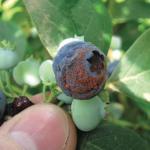Blueberry IPM - Anthracnose Ripe Rot
Blueberry - Anthracnose Ripe Rot (Colletotrichum acutatum)
ID/Disease Cycle:
Blueberry Anthracnose (aka ‘ripe rot’), primarily damages fruit but may also infect twigs and spurs. It causes a salmon or rust-colored berry rot, which can ruin fruit quality. Blossom clusters will turn brown or black. Infected fruit shows bright pink spore masses at the blossom end. Stem cankers with raised purple margins can occur but are rare. Young girdled stems die back, resulting in a brown withering of the leaves. The disease is especially prevalent during hot, muggy weather and frequently occurs post-harvest.
Blueberry Anthracnose is caused by the fungus Colletotrichum acutatum. C acutatum has a wide host range and causes ripe rot in several fruit and vegetable crops. In blueberries, the fungus overwinters in dead or diseased twigs, bud scales, fruit spurs, and cankers. Floral bud scales are considered the most important source of inoculum. Spores are released in spring, and are spread by rain and wind. Blossom infections usually remain symptomless until the resulting fruit begin to ripen. Mature fruit and succulent tissue may also be infected. Spores produced on infected tissues may perpetuate disease spread as long as warm, wet conditions continue. At 25°C (77°), at least 8 hours of leaf wetness is required for infection to occur; a longer leaf wetness period is required for infection to occur at higher or lower temperatures.
There is some variability in susceptibility to Anthracnose among blueberry cultivars. Michigan State University conducted some cultivar trials and determined susceptibility ratings that are shown below.
Table 1) Susceptibility of highbush blueberry cultivars to anthracnose fruit rot. Rating is based on field observations as well as the proportion of fruit decay after artificial inoculation: 0-15%= resistant, 16-30%= moderately resistant, 31-50%= moderately susceptible, and 51-100%= susceptible (Polashock et al., 2005, Plant Disease 89:33-38)
|
Susceptible |
Moderately Susceptible |
Moderately Resistant |
Resistant |
||
|
Bluecrop Bluegold Blueray Bluetta Cara’s Choice Chanticleer Darrow Earliblue Hardyblue Herbert Katherine |
Lateblue Nui Olympia Patriot Pemberton Puru Rancocas Sierra Spartan Toro |
Berkeley Bluejay Bonus Cabot Collins Hanna’s Choice Jersey Nelson |
Northland O’Neal Reka Rubel Stanley Sunrise Weymouth |
Aurora Blue Rose Blue Haven Brigitta Blue Elizabeth Croatan* Murphy* Duke* |
Elliot Draper Legacy Liberty |
* Duke, Muphy and Croatan show field resistance even though they were susceptible or moderately susceptible in the inoculation tests.
Damage:
Impact from this disease is mainly on fruit quality, harvestable yield, and post-harvest quality. Some yield reduction can occur from blossom infections and twig blight.


Management:
Monitoring:
Consult scouting records from previous years to determine if build-up of this disease is indicated. Monitor weather conditions to identify likely infection periods. Scout fields beginning at bloom for symptomatic tissue.
Control strategies:
Cultural/Biological:
- Grow resistant cultivars when available. ‘Elliott’, ‘Legacy’, and ‘Reveille’ are among these.
- Prune bushes to open the canopy to light, air, and spray penetration.
- Remove and destroy prunings.
- Harvest frequently to limit the amount of overripe fruit present in the field.
- Refrigerate harvested fruit as soon as possible.
Chemical:
- Refer to the New England Small Fruit Management Guide for specific materials and rates recommended for managing mummy berry.
- Apply recommended fungicides if scouting and weather monitoring indicate risk of infection.
- Repeat fungicide applications at recommended intervals if weather conditions are conducive to infection.
- Rotate fungicide materials from different FRAC groups to avoid promoting the development of resistant strains of this disease.
References:
Anthracnose Fruit Rot (Ripe Rot) of Blueberries. Michigan Blueberry Fact Sheet. https://archive.lib.msu.edu/DMC/extension_publications/e3039/E3039.pdf. Timothy Miles and Annemiek Schilder, Michigan State Univ.
Date: January 2020
Additional information available on the MYIPM app: https://apps.bugwood.org/apps/myipmseries/
Note: This information is for educational purposes only and is reviewed regularly for accuracy. References to commercial products or trade names are for the reader’s information. No endorsement is implied, nor is discrimination intended against similar products. For pesticide products please consult product labels for rates, application instructions and safety precautions. The label is the law. Users of these products assume all associated risks.
This work was supported in part by funding provided by USDA NIFA Extension Implementation Program, Award No. 2017-70006-27137